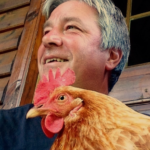
If you’ve ever watched chickens bustling around in a yard, you know they seem to go about their routines without using their little minds much. In fact, their behavior is quite complex, fascinating, and baffling. I aim to help you understand that these common chicken behaviors are more than random acts. They are intrinsic parts of your chickens’ lives that ensure their survival and indicate their overall health and comfort.
You’ll learn about chickens’ daily behaviors, such as scratching and pecking, which are not blind habits but meaningful activities tied closely to their natural instincts and need to forage for food.
But there’s more to chicken behavior than just the search for the next meal. Dustbathing, another routine you may have witnessed, helps keep their feathers in top condition and is a communal activity that fosters social bonding among the flock.
And then there’s the complex communication system, which often goes unnoticed by the casual observer. Each chicken has a distinctive voice that serves a purpose, from alerting others to food to signaling danger.
Above all, the social hierarchy, or pecking order, is an essential element governing these interactions. Understanding this pecking order can give you insights into how peace and harmony are obtained and maintained within your flock.
Observing and interpreting these behaviors can enhance one’s ability to care for one’s chickens, ensuring their happiness and health and yielding a rewarding chicken-keeping experience. In fact, once you understand their language, you can save their lives by responding to their cries for help!
Stick around as we decode the specifics of each behavior, starting with scratching and pecking in the next section. Trust me, your chickens will thank you for paying attention.
Scratching and Pecking
Scratching and pecking aren’t just random chicken behaviors; they’re essential to a chicken’s daily life. These activities are deeply ingrained in their instincts and serve several pivotal roles.
You’ll often see your chickens scratching the ground with their feet, tossing aside leaves and debris in a frenzied dance. They follow up with precise pecks, looking for seeds, insects, or any morsel that nature has tucked away. This isn’t just about satisfying hunger; it’s also about engaging their natural foraging instincts.
A chicken’s scratching habit is like nature’s tiller, turning over the soil to expose fresh bugs and aerating the earth. If you’re watching your chickens scratch around and you’re wondering what they might be finding, don’t worry too much. They’re experts at discovering the smallest seeds or critters we would likely miss. Yes, even ticks! That is a huge plus!
But there’s another layer here. You can learn much about their health and well-being by observing how and where your chickens scratch and peck. Are they scratching less vigorously than usual? It might be a sign of nutritional deficiency or illness. Are they avoiding certain areas of their run? Maybe something in that spot is making them uneasy.
As we shift from the why to the how you will find out about dustbathing in the next section. Like scratching and pecking, dust baths are more than just a peculiar chicken quirk; they are crucial in maintaining your flock’s plumage and comfort.
The Social Spa – Dust Baths and Their Purpose

Chickens aren’t just aimlessly kicking up dirt; they’re engaging in a vital self-care routine known as dust bathing. Unlike humans who hit the showers, chickens have their own way of staying clean and pest-free, and that’s by rolling in dry, fine particles. This instinctual behavior mirrors the practices of many birds that understand the importance of regular maintenance for feather and skin health.
When chickens dustbathe, they do more than just frolic in the dirt. They’re actually performing a clever, natural method to control parasites like mites and lice. Coating their feathers with dust creates an inhospitable environment for these pests. This is crucial for their overall health and comfort and alleviates the need for frequent chemical treatments.
It also reduces the frequency of your need to chemically treat their coop in the case of a parasite infestation.
But dusting is not all business; there’s pleasure in the process as well. Dustbathing is often a communal activity that reinforces social bonds among the flock. Watching chickens take turns rolling, shaking, and fluffing their feathers together can display harmony and shared routines. It can even become competitive, as chickens may vie for prime spots in the most tantalizing dust pits.
As they indulge in this behavior, chickens are exhibiting a comfort level with their surroundings and ensuring their social pecking order is intact. Understanding this activity offers insights into the complex social structure of your flock, paving the way for comprehending the vocal signals and hierarchy that will be discussed next.
Believe it or not, if you are new to raising chickens, you will eventually come to know your chickens’ looks, sounds, behaviors, and general idiosyncrasies. Yep, you will.

Understanding the Pecking Order and Communication and Hierarchy in Chicken Social Life
Chickens aren’t just aimlessly clucking around but engaging in a complex social dialogue. And when you’re attuned to their language, you’ll learn about how they interact. Each chicken has its unique voice, which is fascinating, isn’t it? They use these voices to express many needs and reactions, from alerting others of food to signaling distress.
Let’s take a look at what they’re saying to each other and us if we are paying attention. They make many different sounds. Here are quite a few thanks to Gail Damerow:
- Peep of Pleasure – Chicks emit a soft peep to tell Mama where they are.
- Happy Trill – Chicks trill when finding food or when nestling.
- Distress Chirping – Loud and sharp call when chicks are uncomfortable.
- Panic – This peep is more insistent and penetrating than the distress peep.
- Fear Trill – Similar to happy trill but more like a police whistle.
- Startled Chirp – Several sharp chirps quickly dissipate once the chick knows what’s happening. Imagine picking one up.
- Mama Cluck – A short, low-pitched sound repeated over and over lets chicks know to stay close.
- Hush – A low error that tells chicks to be still because danger is afoot.
- “I laid an egg!” – A cackle that often sets off the entire flock. A hen does this for a minute when she gets off the nest. It’s not clear why they do this.
- Brooding Hiss – A hiss that warns others that Broody is annoyed by your presence.
- Brooding Growl – This is a hissy growl that might be accompanied by ruffling and a peck. It means a brooding hen is ready to fight for her right to privacy.
- Contentment – A chuck, chuck, chuck that is neither fast nor high-pitched. Imagine a group of people on a stroll shooting the breeze. You can hear them but can’t make out what they are saying. It lets chickens know others’ locations.
- Startled – Usually, a loud initial “bawk!” followed by many trailing clucks as a chicken runs away from the source.
- Roosters crow for many reasons. At its simplest, it is a male thing.
- Caution – A few quick notes, briefly repeated. Once the caution escalates, it becomes…
- Alarm! – bukbukbukbukBUKAWWK! Again and again. I was sitting inside when I heard my girls start doing this recently. I walked outside to find a fox circling around the yard. I chased it into the woods and have not seen it in a few days. I can still hear the girls carrying on. They were very upset. This is why people don’t free-range their flocks.
Chickens and chicks make many more sounds but are iterations of the ones I’ve listed. For instance, a rooster coos while circling a potential mate and clucks sharply when an imminent aerial attack occurs.
Pecking Order
When it comes to chicken hierarchies, ‘pecking order’ isn’t just a phrase; it’s a real and observable phenomenon. Those at the top get the best resources while lower-ranking individuals wait their turn. This hierarchy affects virtually every aspect of their behavior, from feeding to nesting. Understanding these dynamics is essential to maintaining a peaceful flock and preventing bullying.
In the pecking order, each bird knows their place, but watch out for changes like new additions to the coop or when a dominant chicken is removed.
Keep in mind that your role as a chicken keeper is integral. Observing your flock and intervening when necessary helps maintain harmony. Don’t worry too much about occasional squabbles; they are a normal part of flock life. Only intercede if necessary to ensure your chickens are happy, healthy, and well-socialized.
To sum it up, your chickens’ behaviors are rich with meaning. Every action has purpose and importance in their world, from pecking the ground to establishing their social standing. Paying attention to these details will improve their quality of life and give you a deeper appreciation for these remarkable birds.
Dave

Chickenmethod.com

